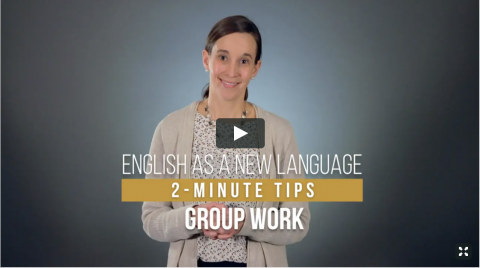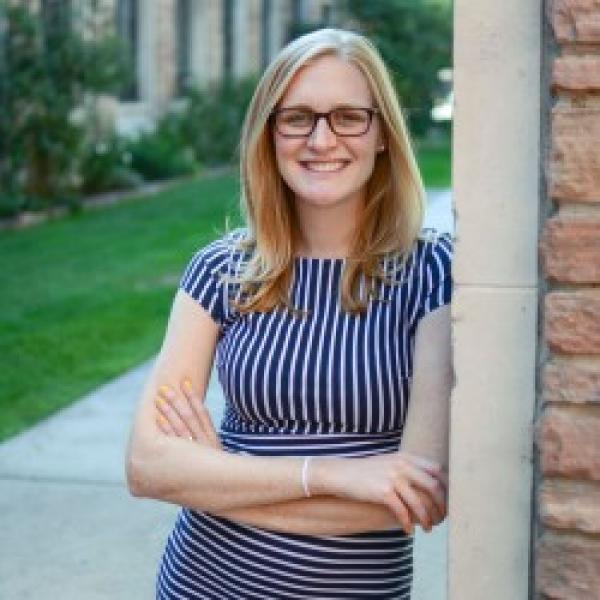Rethinking Effective Writing Instruction for English Learners: The Promise of Genre-Based Pedagogy
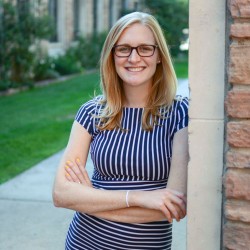 Dr. Laura Hamman-Ortiz is an educational linguist whose research explores how to support language and literacy learning for emergent bilingual students. Dr. Hamman-Ortiz is currently a Post-Doctoral Research Associate with the Department of Educational Equity and Cultural Diversity (EECD) at the University of Colorado-Boulder, where she is collaborating on a three-year design-based research study that explores the impact of a genre-based approach to writing instruction in bilingual classrooms. She is also a Coyle Fellow with the Center for Literacy and part-time faculty with the English as a New Language (ENL) program within the Alliance for Catholic Education (ACE) at the University of Notre Dame.
Dr. Laura Hamman-Ortiz is an educational linguist whose research explores how to support language and literacy learning for emergent bilingual students. Dr. Hamman-Ortiz is currently a Post-Doctoral Research Associate with the Department of Educational Equity and Cultural Diversity (EECD) at the University of Colorado-Boulder, where she is collaborating on a three-year design-based research study that explores the impact of a genre-based approach to writing instruction in bilingual classrooms. She is also a Coyle Fellow with the Center for Literacy and part-time faculty with the English as a New Language (ENL) program within the Alliance for Catholic Education (ACE) at the University of Notre Dame.
The ability to write well is essential for school success. And, while writing has long been considered a core academic skill, some researchers argue that we are currently experiencing an unprecedented “rise of writing” (Brandt, 2015), an era when written knowledge production—for record-keeping, information-sharing, relationship-building, etc.—has come to dominate our professional and social lives. Be that as it may, results from national assessments reveal that too many students continue to underperform in academic writing. English learners (ELs), in particular, often struggle to reach grade-level benchmarks. Take, for example, the most recent data from the National Assessment of Educational Progress (NAEP): 65% of eighth grade ELs performed below basic proficiency in writing, compared to only 17% of eighth grade proficient English speakers (NCES, 2012).
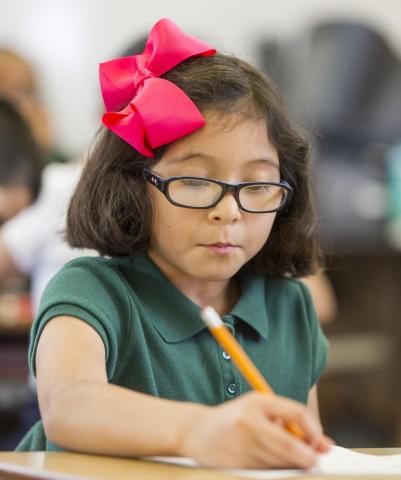 These persistent inequalities are, in part, related to the instruction students receive, as many educators report having little to no training in teaching writing (Gilbert & Graham, 2010). Similarly, I recall feeling underprepared to teach writing during my first year as a second-grade teacher. In my teacher preparation coursework, I had (briefly) learned about Writing Workshop, a student-centered approach grounded in the notion that, to become strong writers, students should engage in frequent, extended writing sessions (Calkins, 2006; Graves, 1994). Put simply, to learn to write, students need time to write. In my classroom, I tried to implement the workshop approach with fidelity: I dedicated long blocks of time to independent writing and incorporated the requisite mini-lessons, student conferencing, and sharing time. And, while this model seemed to help my students revise their work and build stamina (i.e. write more and for longer), many of my students—my ELs, in particular—continued to struggle with writing.
These persistent inequalities are, in part, related to the instruction students receive, as many educators report having little to no training in teaching writing (Gilbert & Graham, 2010). Similarly, I recall feeling underprepared to teach writing during my first year as a second-grade teacher. In my teacher preparation coursework, I had (briefly) learned about Writing Workshop, a student-centered approach grounded in the notion that, to become strong writers, students should engage in frequent, extended writing sessions (Calkins, 2006; Graves, 1994). Put simply, to learn to write, students need time to write. In my classroom, I tried to implement the workshop approach with fidelity: I dedicated long blocks of time to independent writing and incorporated the requisite mini-lessons, student conferencing, and sharing time. And, while this model seemed to help my students revise their work and build stamina (i.e. write more and for longer), many of my students—my ELs, in particular—continued to struggle with writing.
Many education researchers have critiqued the lack of explicit language instruction in the mainstream classroom, arguing that ELs need systemic instruction in academic language to be successful in school (de Jong & Harper, 2005; Dutro & Helman, 2009). It is worth recalling that ELs are simultaneously learning a new language and learning in a new language. They are often unfamiliar with the types of texts and discourses valued in school contexts. Thus, in order to effectively support ELs in the classroom, it is essential that writing instruction be grounded in an approach that demystifies the “language of schooling” (Schleppegrell, 2004).
One such approach to teaching writing is genre-based pedagogy. Genre-based pedagogy is a language-centered framework for writing instruction built on the premise that all writing is about making choices to effectively communicate a message to a given audience. This model is rooted in Michael Halliday’s (1993) systemic functional linguistics (SFL), which understands language not as a system of rules but as a “set of resources for making meaning” (Rose & Martin, 2012, p. 21). At school, students encounter different ‘genres’—texts with a common social purpose—such as biographies, fictional narratives, procedures, reports, and arguments. A genre approach to writing instruction helps students learn to identify the structural and linguistic components unique to each genre so that they can make informed choices in their own writing.
I first encountered genre-based pedagogy in 2013 while working as a teacher educator at the University of Wisconsin-Madison, and it has continued to animate my work with teachers participating in the English as a New Language (ENL) program at the University of Notre Dame. The framework I’ve found most helpful for implementing this approach is the Teaching and Learning Cycle (TLC), a model developed in the 1980s by researchers and teachers in Australia. The TLC follows a gradual release of responsibility approach—moving from teacher-led activities to student-led independent work—while also incorporating explicit language teaching. There are four stages in the TLC: building the field, deconstruction of text, joint construction of text, and independent construction of text (Rothery, 1996; see Figure 1 for my visual adaptation of the original TLC, incorporating recommendations from Brisk, 2015). In what follows, I provide a brief overview of each stage, using the genre of report as an example of how the TLC might be implemented in the classroom.
Figure 1. The Teaching and Learning Cycle (TLC)


1. Build the Field // The first step of the TLC is to build the “field” or to develop the content knowledge that students will need in order to write. For example, if I want my third-grade students to write reports about animals that live in and around ponds, I might begin by showing them a short video about pond ecosystems or by having students read introductory texts about different pond animals. We might also invite an expert to come to our classroom to speak about pond animals and/or conduct a class fieldtrip to a local pond to conduct research on the plant and animal inhabitants. Note: While building the field is step one—as it is essential that students have substantive background knowledge on a topic before they are asked to write about it—I would continue to develop students’ content knowledge throughout the unit, deepening their expertise on the topic.
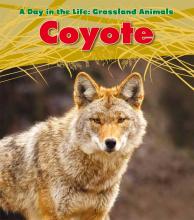 2. Deconstruct Mentor Text(s) // The second step is to present students with mentor texts for the chosen genre and to spend time deconstructing the texts together. Importantly, a mentor text does not have to be on the same topic; rather, it just has to be an authentic representation of the genre. For example, I might use the book Coyote (A Day in the Life: Grassland Animals) by Louise Spilsbury to model the report genre with my third-grade students. We would begin by reading the text together. If this is the first time we have discussed this genre, it is important to discuss its purpose. The purpose of a report, for example, is to give information. Then, we would review the text, analyzing its structural components. Brisk (2015) recommends using a graphic organizer to help students learn genre structure (see Figure 2 for an example). Reports are structured with (1) a general statement, (2) a series of sub-topics with more detailed information about the topic, and (3) (sometimes) a summarizing comment. The Coyote text begins with the general statement “Coyotes are a type of wild dog,” includes information about coyotes that can be divided into several subtopics (e.g., size, appearance, habitat, food), and has no summarizing comment. As a class, we would complete the graphic organizer using the Coyote text, identifying the language that fits within each section. In subsequent lessons, I would repeat this exercise with different mentor texts, perhaps having students analyze a text in small groups as they become more familiar with the report genre.
2. Deconstruct Mentor Text(s) // The second step is to present students with mentor texts for the chosen genre and to spend time deconstructing the texts together. Importantly, a mentor text does not have to be on the same topic; rather, it just has to be an authentic representation of the genre. For example, I might use the book Coyote (A Day in the Life: Grassland Animals) by Louise Spilsbury to model the report genre with my third-grade students. We would begin by reading the text together. If this is the first time we have discussed this genre, it is important to discuss its purpose. The purpose of a report, for example, is to give information. Then, we would review the text, analyzing its structural components. Brisk (2015) recommends using a graphic organizer to help students learn genre structure (see Figure 2 for an example). Reports are structured with (1) a general statement, (2) a series of sub-topics with more detailed information about the topic, and (3) (sometimes) a summarizing comment. The Coyote text begins with the general statement “Coyotes are a type of wild dog,” includes information about coyotes that can be divided into several subtopics (e.g., size, appearance, habitat, food), and has no summarizing comment. As a class, we would complete the graphic organizer using the Coyote text, identifying the language that fits within each section. In subsequent lessons, I would repeat this exercise with different mentor texts, perhaps having students analyze a text in small groups as they become more familiar with the report genre.
Figure 2. Graphic Organizer for Report Genre (from Brisk, 2015)

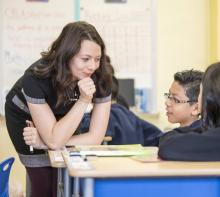 3. Jointly Construct Text(s) // The next step in the TLC is to construct a model text of the genre as a class. I would likely choose a topic that is related to the pond unit so that students can also learn some relevant vocabulary. For example, we might write our joint report on snapping turtles, a common pond dweller. This stage of the TLC also provides a good opportunity to teach research skills, as I model for students how to take notes as we review different sources for information on snapping turtles. As we gather information, we would record it in a report graphic organizer, beginning with subtopics and then writing a general statement based on what we had learned about snapping turtles.
3. Jointly Construct Text(s) // The next step in the TLC is to construct a model text of the genre as a class. I would likely choose a topic that is related to the pond unit so that students can also learn some relevant vocabulary. For example, we might write our joint report on snapping turtles, a common pond dweller. This stage of the TLC also provides a good opportunity to teach research skills, as I model for students how to take notes as we review different sources for information on snapping turtles. As we gather information, we would record it in a report graphic organizer, beginning with subtopics and then writing a general statement based on what we had learned about snapping turtles.
Here, and throughout the TLC, I would also incorporate mini-lessons on the linguistic features of reports, returning to our mentor texts for analysis. For example, reports are usually written with generalized participants (e.g., we talk about “coyotes” not “the coyote” or “a coyote”) and use noun groups to ‘pack’ information into the text (e.g., “Coyotes turn their big, pointed ears to hear sounds from far away” rather than “Coyotes turn their ears to hear sounds from far away. Their ears are big. Their ears are pointed.”). As a class, we would use these mini-lessons to revise and improve our jointly constructed report.
4. Construct Text Independently // During the last stage of the TLC, students write their own texts. Brisk (2015) notes that, instead of having students write independently, it can also be helpful—especially with a new genre—for students to construct texts in small groups or pairs. This phase incorporates many of the wonderful elements from process-based approaches to writing (like Writing Workshop), including conferencing, revising, and sharing. However, unlike a purely process-based approach, with the TLC, students have spent a significant amount of time learning how to write academic texts before they are asked to produce their own writing. It is important to note that the TLC is a recursive process. Thus, even during this final phase, students should be engaged in analyzing texts and learning new linguistic features that can make their writing stronger. That said, in this phase, I would more likely draw sample excerpts from student writing for analysis, to target the specific areas where I see that my students need more support.
I hope that this brief overview of the TLC has demonstrated the potential of rethinking writing from a language-centered perspective. It is worth noting that, while this approach is especially beneficial for ELs, many teachers I’ve worked with have shared that more intentional planning for language has helped them to better support all of their students. Thus, genre-based pedagogy does not need to serve as an ‘add on’ to an existing curriculum; rather, it can become the framework through which all writing instruction is reimagined.
A few final words of advice for supporting ELs in academic writing:
- Use strong mentor texts when introducing a written genre.
- Learn about the language features of genres you teach.
- Use (or create) graphic organizers to model the organizational structure of written genres.
- Teach writing across the curriculum, not only during language arts.
- Teach students how to write, don’t just give students time to write.
Happy Reading,
Dr. Laura Hamman-Ortiz
Recommended Texts for Further Reading
Brisk, M. E. (2015). Engaging students in academic literacies: Genre-based Pedagogy for K-5 classrooms. New York, NY: Routledge.
- A great resource for implementing genre-based pedagogy! Includes detailed descriptions of each genre, with instructional strategies, lists of sample mentor texts, and examples of graphic organizers.
Derewianka, B., & Jones, P. (2016) Teaching language in context (2nd ed.). Melbourne, Australia: Oxford University Press.
- Another wonderful resource for learning more about the genres and associated language features that students encounter in school. Specific pedagogical strategies are also provided.
Gibbons, P. (2015). Scaffolding language, scaffolding learning: Teaching English language learners in the mainstream classroom (2nd ed.).
- One of my favorite texts to use in teacher education courses. Chapter five specifically addresses writing through a genre-based lens (with teaching strategies and examples), although the entire book is a great resource for teachers seeking to better support their English learners.
Check out more best practices for teaching ELs with English as a New Language's monthly 2-Minute Tips!
References
Brandt, D. (2015). The rise of writing: Redefining mass literacy. Cambridge, UK: Cambridge University Press.
Brisk, M. E. (2015). Engaging students in academic literacies: Genre-based pedagogy for K-5 classrooms. New York, NY: Routledge.
Calkins, L (2006). A guide to the writing workshop, Grades 3-5. Portsmouth, NH: First Hand.
Cummins, J. (2000). Language, power, and pedagogy: Bilingual children in the crossfire. Cleveland, UK: Multilingual Matters.
de Jong, E., & Harper, C. (2005). Preparing mainstream teachers for English-language learners: Is being a good teacher good enough? Teacher Education Quarterly. 32(2), pp. 101-124.
Dutro, S., & Helman, L. A. (2009). Explicit language instruction: A key to constructing meaning: Research-Based Instruction in Grades K-6. In L. A. Helman (Ed.), Literacy Development with English Learners: Research-Based Instruction in Grades K-6 (pp. 40-63). New York, NY: Guilford Press.
Gilbert, J., & Graham, S. (2010). Teaching Writing to Elementary Students in Grades 4–6: A National Survey Teaching Writing to Elementary Students in Grades 4 – 6: A National Survey. Source: The Elementary School Journal, 110(4), 494–518.
Graves, D. (1994). A fresh look at writing. Portsmouth, NH: Heinemann.
Halliday, M. A. K. (1993). Towards a language-based theory of learning. Linguistics and Education, 5, 93–116.
National Center for Education Statistics (NCES). (2012). The Nation’s Report Card: Writing
2011 (NCES 2012-470). Institute of Education Sciences, U. S. Department of Education: Washington, D.C. Retrieved from https://nces.ed.gov/nationsreportcard/.
Rose, D., & Martin, J. R. (2012). Learning to write, reading to learn: Genre, knowledge, and pedagogy in the Sydney school. London: Equinox.
Rothery, J. (1996). Making changes: Developing an educational linguistics. In R. Hasan & G. Williams (Eds.), Literacy in society (pp. 86–123). London: Longman.
Schleppegrell, M. (2004). The language of schooling: A functional linguistics perspective. Mahwah: Lawrence Erlbaum Associates.
Spilsbury, L. (2011) Coyote (A day in the life: Grassland animals). Chicago, IL: Heinemann Library.
